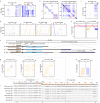Divergent evolution of male-determining loci on proto-Y chromosomes of the housefly
- PMID: 39013946
- PMCID: PMC11252125
- DOI: 10.1038/s41467-024-50390-1
Divergent evolution of male-determining loci on proto-Y chromosomes of the housefly
Abstract
Houseflies provide a good experimental model to study the initial evolutionary stages of a primary sex-determining locus because they possess different recently evolved proto-Y chromosomes that contain male-determining loci (M) with the same male-determining gene, Mdmd. We investigate M-loci genomically and cytogenetically revealing distinct molecular architectures among M-loci. M on chromosome V (MV) has two intact Mdmd copies in a palindrome. M on chromosome III (MIII) has tandem duplications containing 88 Mdmd copies (only one intact) and various repeats, including repeats that are XY-prevalent. M on chromosome II (MII) and the Y (MY) share MIII-like architecture, but with fewer repeats. MY additionally shares MV-specific sequence arrangements. Based on these data and karyograms using two probes, one derives from MIII and one Mdmd-specific, we infer evolutionary histories of polymorphic M-loci, which have arisen from unique translocations of Mdmd, embedded in larger DNA fragments, and diverged independently into regions of varying complexity.
© 2024. The Author(s).
Conflict of interest statement
The authors declare no competing interests.
Figures




References
MeSH terms
Grants and funding
LinkOut - more resources
Full Text Sources

